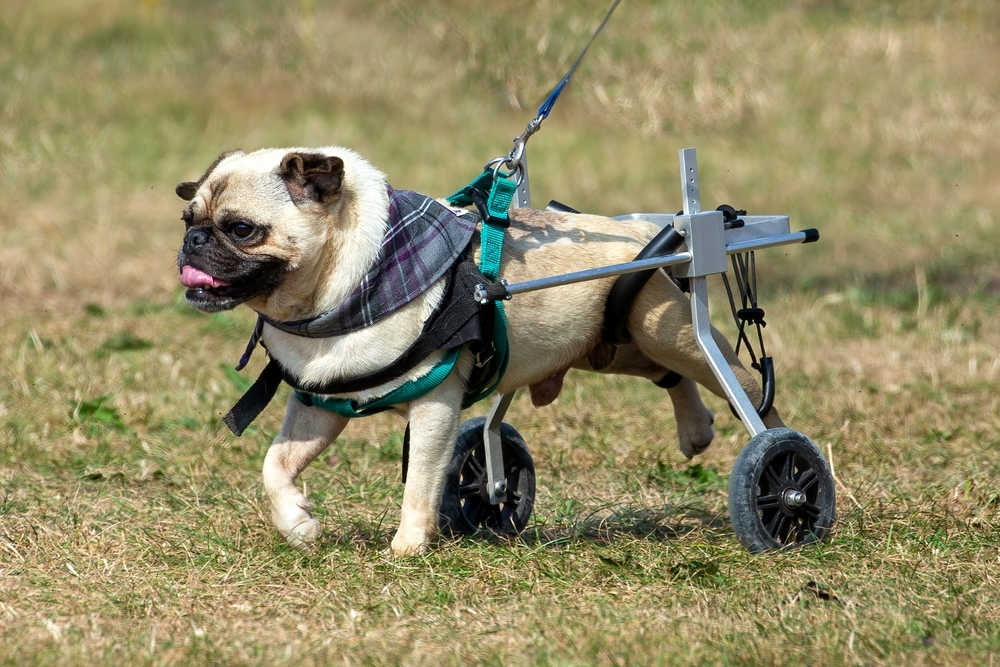Diagnosing IVDD – Is my dog at elevated risk?
If your veterinarian suspects IVDD may be ailing your dog, they will usually begin with a physical exam to check your pet’s orthopedic and neurologic condition. Once IVDD is confirmed, and its severity determined, your pet will either begin conservative treatment to try and prevent further damage without surgery, or they will be referred for x-ray imaging in preparation for surgical intervention
Owners should be aware that these breeds of dog are predisposed to IVDD:
What is the survival rate for IVDD in dogs?

The survival rate for IVDD and the disease’s impact on a dog’s life expectancy depends on the stage of the disease.
IVDD Prognosis and Life Expectancy by Grade
| Grade | Typical symptoms | Prognosis without surgery & recovery time | Prognosis with surgery & recovery time | Life expectancy |
| 1 | Dog may be walking normally or have stiff gait, signs of mild pain along spine, stiff neck | 70-100% Typically 1-3 weeks depending on severity of signs | 95%. Surgery is usually not required at this stage | Dogs with full recovery will have a normal life expectancy |
| 2 | Moderate pain along neck and back; wobbly gait, knuckling of the paws while standing, weakness, reluctance to move, resistance to jumping or climbing | 55-100% typically, 4-6 weeks depending on severity of signs | 95%; dogs can recover in 1-3 weeks, but some may take longer | Dogs with full recovery will have a normal life expectancy |
| 3 | Moderate to severe pain along neck and back, crying in pain when attempting to walk, knuckling and dragging paws while walking, marked weakness or partial limb paralysis, may require assistance to stand and walk | 55-80% minimum of 4-6 weeks; some dogs will require surgery | 80-90%; typical dogs walking again within 1-3 weeks, but some may take 2 or more months | Dogs with full recovery will have a normal life expectancy; early treatment and rehab is key to recovery |
| 4 | Severe pain along back and neck, unable to rise and walk, feels pain in hind limbs | 40-80% Can walk again without surgery | 80-90%; minimum of 6-8 weeks for recovery | Dogs with full recovery have normal life expectancy; delaying surgery up to 48 hours after injury will not affect outcome |
| 5 | Paralysis of affected limbs, loss of pain sensation, incontinence | 30% or less Walk again without surgery | 50-60% Recovery can vary from 6-8 weeks to 9 or more months | For dogs that don’t recover, life expectancy is greatly shortened and quality of life is limited due to nerve damage, incontinence, pain; and paralysis; your vet may recommend euthanasia |
Survival rates from IVDD diagnosis and prognosis, 5-point grading scale for Dachshunds with IVDD courtesy of Marianne Dorn BVM&S PGCert SART MRCVS.
Special Concerns for IVDD Affected Dogs
In some rare cases of IVDD, a dog may experience permanent and irreversible paralysis in their hindquarters. There are still ways to manage pain in these cases and allow the pooch to move around freely.
A special wheelchair called the K-9 cart allows dogs to rest their backsides while using their front legs to pull themselves along. In this situation, many pups can live happy lives with very few restrictions on the kind of movement they experienced before IVDD. They will still be able to fetch, play freely, and join their pet parent for invigorating walks.
Old age is the primary culprit of IVDD, but there are things pet parents can do (especially with susceptible breeds) that can help keep the disease at bay.
With smaller breeds, walking with a harness is always a good idea. Proper weight management can help prevent undue stress on the dog’s back. Finally, it’s never too early to provide steps or ramps to help your pet on and off beds and high furniture.
*Internal Claims Data, 2019 The information presented in this article is for educational and informational purposes only and does not constitute or substitute for the advice of your veterinarian.

How to handle and care for a dog with IVDD. How to carry, pick up and move a painful dog.
If your canine friend falls in the category of dogs that are highly prone to life-threatening diseases such as Intervertebral Disk Disease (IVDD). You must be wondering the best form of treatment, well for a long time surgery has been recommended as the most effective mode of treating IVDD. IVDD surgery can be quite expensive especially when you do not have insurance cover for your pet. This article explores whether your canine friend can actually recover from IVDD without surgery.